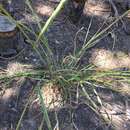Associations
provided by BioImages, the virtual fieldguide, UK
In Great Britain and/or Ireland:
Foodplant / parasite
Blumeria graminis parasitises live Ceratochloa marginata
Description
provided by eFloras
Perennial. Culms tufted, ca. 50 cm tall, ca. 5 mm in diam. Leaf sheaths retrorsely pubescent; leaf blades 10–20 cm × 4–10 mm, pubescent. Panicle erect, rather narrow, 10–15 cm; primary branches 3–5 cm, lower branches erect or spreading, each bearing 1 or 2 spikelets. Spikelets 20–30 × 5–8 mm, florets 9–13, overlapping; rachilla internodes not visible; lower glume 6–7 mm, upper glume ca. 8 mm, apex acuminate; lemmas 10–20 × ca. 2.2 mm in side view, keeled, pubescent, margins membranous, awned from apex; awn 5–7 mm. Fl. May–Jun. 2n = 28, 42, 56, 70.
- license
- cc-by-nc-sa-3.0
- copyright
- Missouri Botanical Garden, 4344 Shaw Boulevard, St. Louis, MO, 63110 USA
Habitat & Distribution
provided by eFloras
Roadsides, forest margins, moist places, adventive. Hebei [native to North America].
- license
- cc-by-nc-sa-3.0
- copyright
- Missouri Botanical Garden, 4344 Shaw Boulevard, St. Louis, MO, 63110 USA
Physical Description
provided by USDA PLANTS text
Perennials, Terrestrial, not aquatic, Stems nodes swollen or brittle, Stems erect or ascending, Stems geniculate, decumbent, or lax, sometimes rooting at nodes, Stems caespitose, tufted, or clustered, Stems terete, round in cross section, or polygonal, Stem internodes hollow, Stems with inflorescence less than 1 m tall, Stems with inflorescence 1-2 m tall, Stems, culms, or scapes exceeding basal leav es, Leaves mostly cauline, Leaves conspicuously 2-ranked, distichous, Leaves sheathing at base, Leaf sheath mostly closed, Leaf sheath hairy, hispid or prickly, Leaf sheath hairy at summit, throat, or collar, Leaf sheath and blade differentiated, Leaf blades linear, Leaf blade auriculate, Leaf blades 2-10 mm wide, Leaf blades 1-2 cm wide, Leaf blades mostly flat, Leaf blades mostly glabrous, Leaf blades more or less hairy, Ligule present, Ligule an unfringed eciliate membrane, Inflorescence terminal, Inflorescence an open panicle, openly paniculate, branches spreading, Inflorescence solitary, with 1 spike, fascicle, glomerule, head, or cluster per stem or culm, Inflorescence with 2-10 branches, Inflorescence branches more than 10 to numerous, Flowers bisexual, Spikelets pedicellate, Spikelets laterally compressed, Spikelet 3-10 mm wide, Spikelets with 3-7 florets, Spikelets with 8-40 florets, Spikelets solitary at rachis nodes, Spikelets all alike and fertille, Spikelets bi sexual, Spikelets disarticulating above the glumes, glumes persistent, Spikelets disarticulating beneath or between the florets, Rachilla or pedicel glabrous, Glumes present, empty bracts, Glumes 2 clearly present, Glumes distinctly unequal, Glumes shorter than adjacent lemma, Glumes 3 nerved, Glumes 4-7 nerved, Lemmas thin, chartaceous, hyaline, cartilaginous, or membranous, Lemma 5-7 nerved, Lemma 8-15 nerved, Lemma glabrous, Lemma body or surface hairy, Lemma distinctly awned, more than 2-3 mm, Lemma with 1 awn, Lemma awn less than 1 cm long, Lemma awn subapical or dorsal, Lemma awns straight or curved to base, Lemma margins thin, lying flat, Lemma straight, Lemma surface pilose, setose or bristly, Palea present, well developed, Palea membranous, hyaline, Palea shorter than lemma, Palea 2 nerved or 2 keeled, Palea keels winged, scabrous, or ciliate, Stamens 3, Styles 2-fid, deeply 2-branched, Stigmas 2, Fruit - caryopsis, Caryopsis ellipsoid, longitudinally grooved, hilum long-linear, Caryopsis hairy at apex.
Bromus marginatus: Brief Summary
provided by wikipedia EN
Bromus marginatus is a species of grass known by the common name mountain brome. It is native to western North America, and it is used widely for grazing animals and revegetating landscapes.
This short-lived perennial grass forms a large, shallow root network. The roots give it drought-tolerance, and they persist in the soil long after the plant has died, making it valuable for erosion control. The stems can usually reach one meter in height but are known to reach 1.5 meters. The hairy leaves are up to a centimeter wide. The inflorescence is a nodding panicle of spikelets, each with up to 10 flowers.
In the wild in its native range this grass grows in moister areas in mountain sagebrush, scrub, and meadows into the subalpine climate. It can tolerate thin, dry soils and some shade. It establishes easily and can become weedy. It can be planted on slopes and uneven terrain using a broadcast seeding method.
There are several cultivars of this grass, including 'Garnet', 'Bromar', and 'Tacit'. The latter has been known to produce 15 tons per hectare with 3 to 4 harvests per year.
- license
- cc-by-sa-3.0
- copyright
- Wikipedia authors and editors

